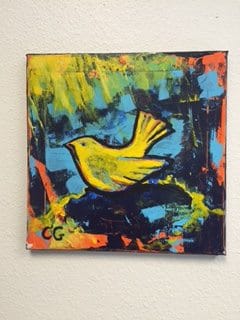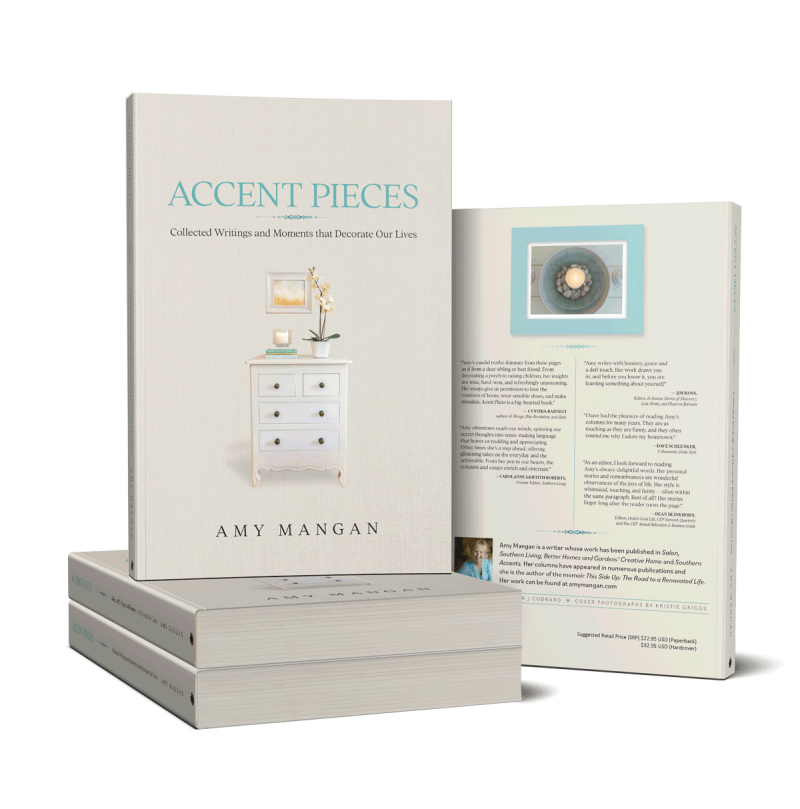
 I am looking at a painting of a yellow bird. It is washed in the colors of Crayola — a bold acrylic palette of oranges, blues, and greens as if the bird is flying through a gumball explosion. I bought the painting at an art therapy exhibit showcasing works by those with Alzheimer’s or dementia. The artist is a 98-year-old woman named Cathy. The bird could be a female Yellow Warbler, petite at 5 inches long with a dark bill.
I am looking at a painting of a yellow bird. It is washed in the colors of Crayola — a bold acrylic palette of oranges, blues, and greens as if the bird is flying through a gumball explosion. I bought the painting at an art therapy exhibit showcasing works by those with Alzheimer’s or dementia. The artist is a 98-year-old woman named Cathy. The bird could be a female Yellow Warbler, petite at 5 inches long with a dark bill.
I am distracted, frequently checking my cellphone. I return to the painting.
I am looking at the opposite corners on the unframed canvas – top left and bottom right. There’s one more color, black and inky as a starless midnight sky, applied in thick clumps on the bottom right corner. At the top, light strokes of yellow – some so faint you can see other colors beneath it – brush the canvas edges. It looks like a hand. No, it’s the sun filtering toward the Yellow Bird That Could Be A Warbler. Strike that. Maybe it’s just yellow paint hastily applied. And I don’t know what kind of bird it is.
I am unsure of many things. My world is unsteady like I’m on one of those giant carnival pirate ships swinging upside down until my stomach is in my throat.
I check my phone again. The painting is propped on a nearby chair.
I am looking at the painter. Curiosity gets the best of me. I find her picture on the gallery’s Facebook page. Cathy, with short cropped gray hair, is sitting in a wheelchair in front of the exhibit’s paintings, one of a bear, another a dog with big brown spots. The artists were told they could paint an animal. In the photo, Cathy is leaning forward holding her yellow bird artwork with a second-place ribbon attached to it. She stares directly toward the camera with a faint, tender smile. I wonder if she smiled like that as a little girl lined up for a school photo, too timid to grin broadly but secretly thrilled to be a first grader.
My phone buzzes. I jump. False alarm.
For someone with Alzheimer’s or dementia, retention of new information is most affected, versus recalling things that happened in the past. Memories are the ones best remembered. The director of the adult daycare where Cathy goes each week says this annual art project gives clients a chance to express themselves when all other forms of communication begin to deteriorate.
I re-check my phone. It will not alert me to danger today. My son and daughter are in college and live away from home. Both have chronic health conditions. Sometimes they need me a little. Sometimes they need me more. None of us picked this scenario, but here we are, at a time we thought we’d be a bit less attached to the nest and one another. The cellphone’s high-tech health alarm connects us when needed. Goodness knows we try to respect the space between us. When there is light, we bask individually beneath the brightness and draw closer when the world swings us upside down in a midnight starless sky. We hold on tight. Together. I hope that’s the part I’ll remember.
I am looking at Cathy’s painting. She told her eldercare director she wasn’t talented. Her husband had all the talent, she said.
All evidence to the contrary, Cathy.
I am looking at brilliant bursts of beauty juxtaposed against black inky shadows in the corner. And a tiny yellow bird at rest, yet, ready for flight.




